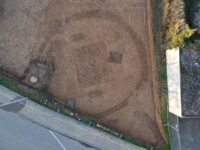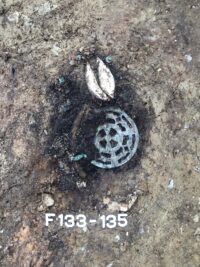 Archaeologists have discovered an early medieval double grave at the center of a circular ditch in Kirchheim am Neckar, southern Germany. Two plots of land in an area of Kirchheim designated as a cultural monument were excavated in advance of development. The presence of a burial ground was known since the 19th century (hence the designation), but the discovery of a double grave inside a ring ditch was unprecedented.
Archaeologists have discovered an early medieval double grave at the center of a circular ditch in Kirchheim am Neckar, southern Germany. Two plots of land in an area of Kirchheim designated as a cultural monument were excavated in advance of development. The presence of a burial ground was known since the 19th century (hence the designation), but the discovery of a double grave inside a ring ditch was unprecedented.
The double grave was found at the southwest end of the burial ground. The circular mark on the ground is all that remains of a large tumulus. The burials consist of two adjacent wooden chamber graves built over carved rock. One belonged to a woman; one to a man. The graves had both been looted in antiquity, but the tomb raiders only pillaged from the knees up. The areas below the knees were untouched, and the looters really missed out.
Below the foot of the buried man were a large ornate bone comb, a ceramic pot, silver sheet bands, a glass tumbler, horse bridles and a bronze vessel filled with organic material and animal bone and a large egg-like object beneath a ceramic bowl. A gold coin was also found in the dead man’s mouth as an obolus [, also known as Charon’s obol, a coin to pay for passage to the underworld].
The remains of a decapitated horse were buried just outside the ring ditch. The presence of horse bridles in the man’s grave suggests the horse was a companion burial.
 The woman’s burial was richly furnished as well, despite having been looted. Grave goods found in her grave include a pearl necklace, a gold pendant inlaid with almandine garnets, a disc brooch, a weaving sword, scissors, a glass beaker and a chatelaine with a decorative disc and a Cypraea snail shell hanging from it. These were high value objects, jewelry and household goods alike. The Cypraea was imported from the Indian Ocean and was a very expensive charm to hang from a belt.
The woman’s burial was richly furnished as well, despite having been looted. Grave goods found in her grave include a pearl necklace, a gold pendant inlaid with almandine garnets, a disc brooch, a weaving sword, scissors, a glass beaker and a chatelaine with a decorative disc and a Cypraea snail shell hanging from it. These were high value objects, jewelry and household goods alike. The Cypraea was imported from the Indian Ocean and was a very expensive charm to hang from a belt.
The excavation of the two properties found 22 more graves, all of them simple inhumations without funerary offerings. These were the kinds of graves archaeologists expected to find at the site, comparable to the ones discovered there in the past. The occupants of the double grave were set apart in the burial ground, separated from the hoi polloi both in location and in the distinctive grandeur of their burials.
The place is apparently located about 40km downstream, but north of Stuttgart, at the river Neckar.
The “great local grave field” –for whatever reason– had been named “Lüssen”, according to the linked article. Large hidden ancient burial sites, usually hidden below ground, are referred to as “Gräberfeld”.
The “ceramic bowl” in the 2nd picture almost looks like a “Tajine” pot from northern Africa.
The traditional tajine pottery consists of two parts: a circular base unit that is flat with low sides and a large cone- or dome-shaped cover that sits on the base during cooking.
Indeed, I wonder about the “large egg-like object” from inside :chicken: